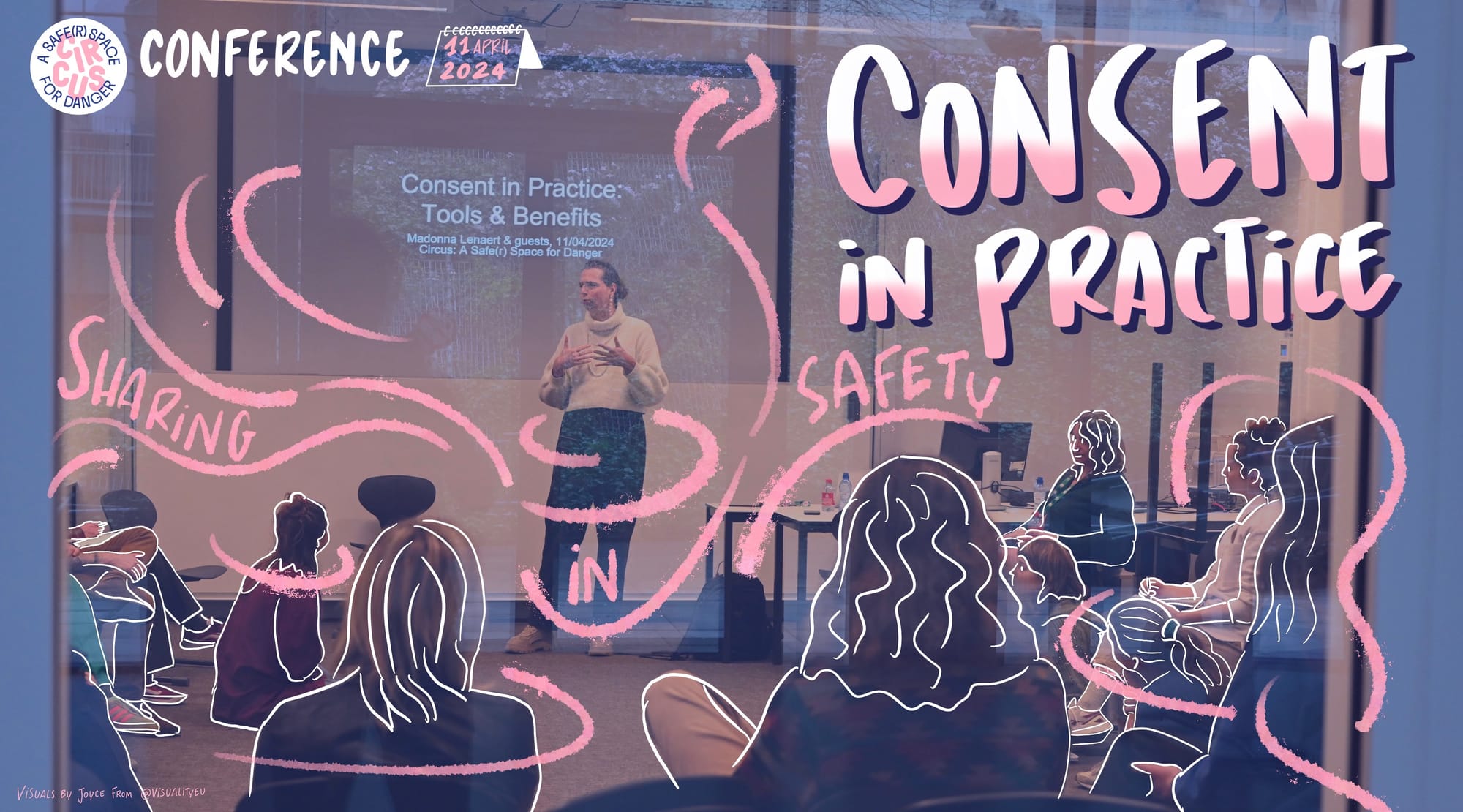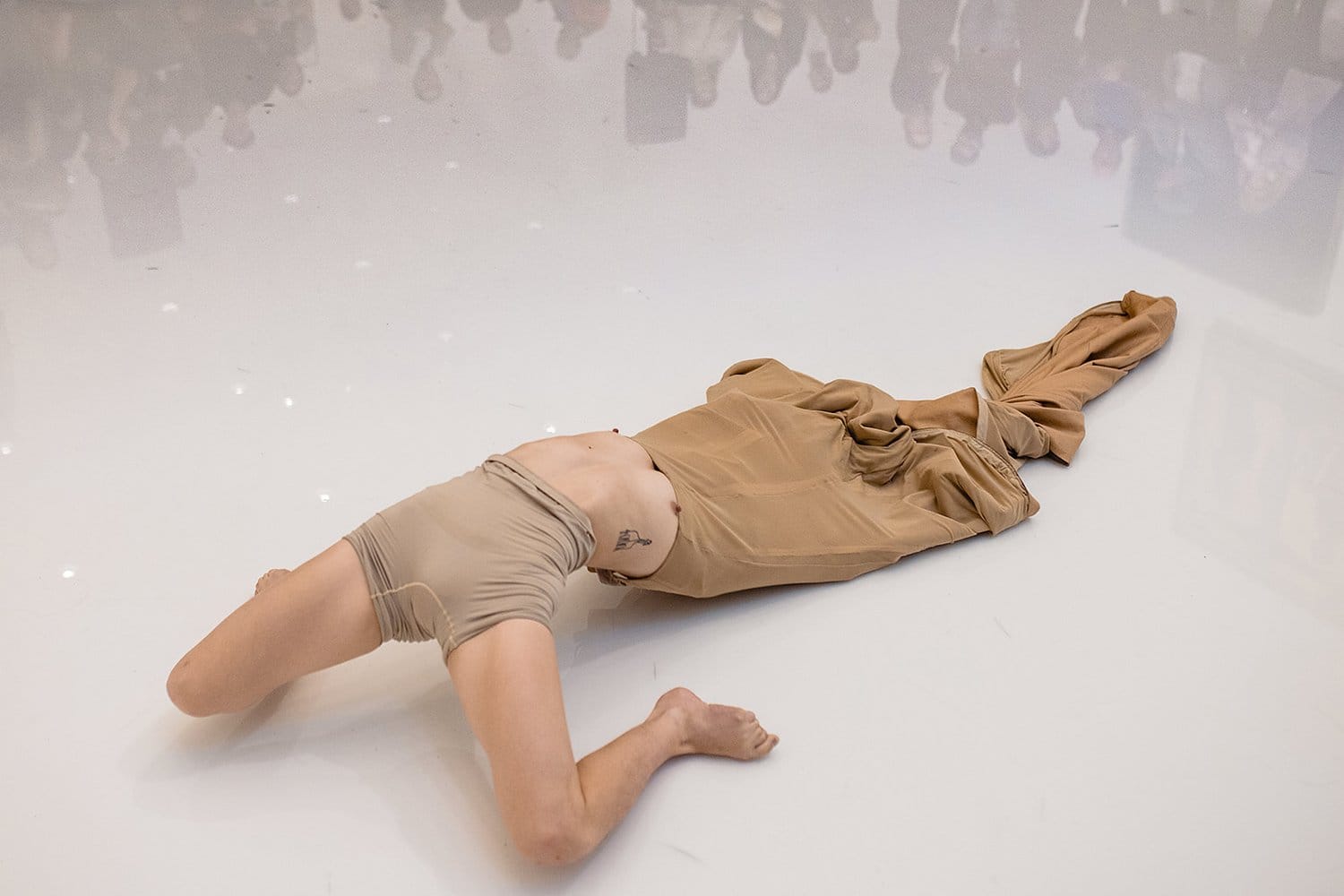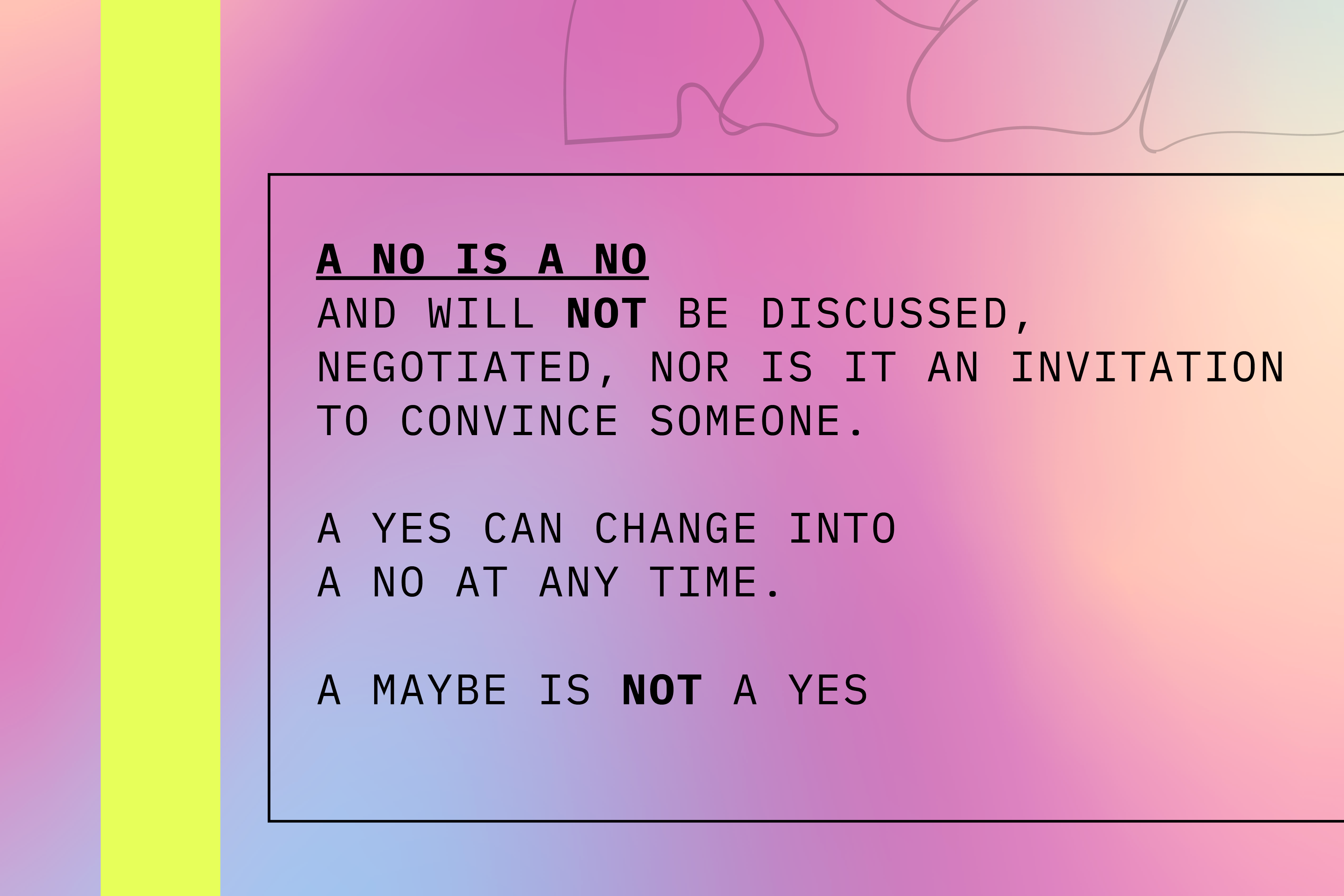Consent: a frame for freedom

In the framework of the conference Circus - a safe(r) space for danger by Circuscentrum, Ell Circo D’ell Fuego and MAD Festival, I participated as a representative guest of There There Company in the workshop Consent in Practice: tools & benefits by Madonna Lenaert (they/them) and have gathered my impressions in this article. What do we as a company know about consent? Do we even sufficiently consider it in the context of our work? The invitation to speak at the panel conversation came to us as a surprise. However, asking these questions seemed like enough of an incentive to join the session, taking it as an opportunity to learn more about the topic and share openly about good practices for creating safer workspaces, something we value highly as a creating circus company. After a theoretical introduction to clarify consent as a concept and a shared reflection on the necessary conditions and benefits of working with and through consent from a company perspective, the invited artists presented their mechanisms for working together safely, and a broader discussion with all the participants followed.
Consent in Practice: Tools & Benefits - Presentation

With THERE THERE Company, two other speakers were invited to participate in this panel workshop experience: Jakobe Geens, Belgian circus artist and artistic director of the circus company Gedachtegang and circus advocate and researcher Bine Maringer. The moderator, Madonna Lenaert, graduated from the drama department of KASK Conservatory Ghent in 2023. As an activist artist, they researched how consent impacts artistic processes. The pivotal findings of this research are also in an article they wrote for Kunstenpunt, the Flemish Expertise Centre for visual arts, performance arts & classical music.
Is it okay for you if I take my shirt off?
Working in an artistic field where bodies and physicality are the main focus and navigating a sector where visible or invisible power dynamics are present in many organisational structures, we should all be involved in thinking and talking about consent in some way. This was a clear viewpoint from the fifteen participants who shared the afternoon with us. A diverse group of circus practitioners entered the room, coming from all corners of the circus field and gathered in a small classroom: artists, teachers, freshly graduated students, artistic directors, and school coordinators.
Upon opening the session, Madonna asked us to create a 'braver space' together. Instead of underlining the safety aspect, a brave space is more an environment where all its inhabitants are confident and relaxed enough to share personal insights and experiences. The idea of the workshop was to share experiences and thoughts all together. To learn from each other and to understand more about how consent is a current issue in today's circus world. Then, Madonna did a short introduction about consent, making me think that most of us know the concept of consent in the context of sexuality but not its practical implications and practises in all other fields, as it refers to a specific way of giving permission. When consent is in action, a moral transformation happens between the asker and the consent giver. To achieve valid consent, a few conditions must be met. Both parties must be capable and informed to validate and understand the situation in which consent is being asked. The person giving consent must be free of pressure and mandated to answer the question. And last but not least, consent is a conventional communicative act, contextual and retractable.
This might all sound very theoretical, but let's translate it to a situation in daily circus life. I will use an example someone gave during the workshop, as it was so simple and recognisable that it perfectly suits this purpose. While training in a packed school training space a male circus artist shouts at his fellow students: “Is it okay for you if I take my shirt off?”. This student respects the agency of his classmates, asking them for permission to show his bare chest. To make their answer valid, fellow students need to understand what it means if this particular person takes his shirt off. Do they feel comfortable about it? Do they feel free of pressure to say no? Or will the person afterwards resent them for speaking out? What are the rules at the school about clothing? Training in the same space as the person asking for permission to take his shirt off gives everyone in the room the mandate to react to his question. It wouldn't make sense if this person called a friend outside of the school to ask for permission in this particular case. To validate the answer of his classmates, this guy needs to hear or see actual permission, the so-called 'communicative act': a nod, a 'no problem', a thumbs up…Saying yes to him today in the context of the training space, doesn't mean he can come and take his shirt off in your living room. Also, if tomorrow you don't feel comfortable about the shirtless-ness anymore, your consent can be retracted.
Is everyone still with me? Let's go on.
What I found particularly interesting in this case, is the fact that the girl telling the story was very surprised about the polite inquiry of her fellow student. Until now she had never questioned whether she would or could reject a request like that. She had never reflected on how she felt being surrounded by the clothed or not-so-clothed bodies training around her, not even giving herself the agency of having an opinion on it. I think this relates to many situations that we currently deal with in circus practice. In the context of consent, we are forced to radically see things from a different perspective. Things that might have 'always been like that'. Things that 'obviously everyone is okay with', because no one ever complained. Things that 'cannot change' because we'd lose freedom, magic, time, and authority.

Physical safety versus bodily integrity?
After the introduction, we were invited to sit together in smaller groups, discussing what brought us to the workshop and why we think consent is important. In the small group I found myself in, some big topics surfaced quickly. Coming from different backgrounds, we all had different experiences with consent and its importance in the work field. However, a big issue which concerns every form of circus education, whether professional or youth and children's education, is consent in the context of spotting. What are good practices? Do you talk about this with (young) students? How can we raise awareness among teachers about consent? How do we give students agency? Again, let me give you some concrete examples that I heard during the conversations. One woman explained how different it is in children's classes compared to youth groups. In working with children, the worries and questions mainly come from the teachers: when do I cross a line? How can I safely touch a young child without crossing their boundaries? What comes first: physical safety ('not falling') or bodily integrity ('not being touched involuntarily')? While youngsters of a certain age, are asking themselves for rules and clarity around consent. In the youth groups in that particular school, they talked about consent at the start of the classes, pointing out the rules and framework regarding physical contact between teachers and students.
In professional circus education spotting becomes an even bigger issue, because not only is the physical safety at stake, but technical progression sometimes depends on spotting. Even if many students and teachers understand the need for a consent talk when spotting, there are also countervoices, questioning how to manage a workable framework regarding this issue. Using arguments like losing time talking about it over and over again, the blurriness of when and how to use touch while spotting and the physical risk that comes with that, loss of authority of the teacher and therefore loss of technical progression. But once the debate on consent in spotting is opened, there's no way back. We will need to find a way of shaping this new, safer training environment, even if this will take time and effort. I was therefore pleasantly surprised to find out that there is a protocol being written on spotting by FEDEC (Fédération de l'Éducation Cirque), that will serve as a guideline for all professional circus schools to target concerns around spotting.

Consent culture in circus
We continued the session with an open panel debate moderated by Madonna, asking questions to the guests (Jakobe, Sabine and myself) and inviting all other participants to react freely during this conversation. We navigated away from the practical, strongly sensitive side of the topic regarding physical touch in a circus context - and opened up on how to create a safe enough environment to bring up consent as a value. Using consent properly means it is necessary to establish formal relationships that respect the implemented criteria. So, the real question is, if we establish a consent culture in the circus sector, what would that look like?
Consent culture refers to a social environment built around mutual consent. An environment that respects a person's decisions, and autonomy over their own body and acknowledges that they are the best judge of their wants and needs. Again, it's not only about sex. The younger generation is often more familiar with this idea, applying it in everyday interactions – remember my first anecdote of the circus artist taking his shirt off. Whilst for older generations this might feel awkward, maybe even exaggerated to openly talk about these things. But clearly, there's a noticeable shift going on, as evidenced by the great interest in this workshop. A change is being driven by the younger generations, rejecting the top-down society, demanding to be seen, heard and given agency. So, what could this look like in a circus context? Of course, this question can't be answered in one article. But again, I'll give some examples that came up during the workshop.
To create a pressure-free environment, we need to be aware of what creates pressure: power dynamics, the pressure that comes with pursuing a career, and the need to make a living. Starting with the awareness of your position.
I experienced in first person how my position in the circus field developed from circus artist and employee to artistic director and employer. As a result of that evolution, it became easier to set boundaries for myself, valuing my work and body. Also, as an artistic director of a company, I became the one in power in certain situations. For us as a company, power comes with responsibility and the awareness that you are in charge of people, of their physical and mental well-being. We try to establish an open and horizontal work dynamic, by being as transparent as possible about decision-making, the financial frame and the general organisation of a project. But most of all we try to never forget our power position, knowing that these dynamics are often invisible for those holding power, and hidden by those who experience them.
Another recurring story was that of the self-imposed pressure to push beyond your limits. In the prevailing culture within schools and among fellow artists, exceeding your (physical) limits is often seen as admirable, a sign of dedication and perseverance. 'Pushing yourself to the limit is cool'. How long can you work while being injured? How long can you endure working under a dominant teacher or director? Combined with the often dependent position we find ourselves in as emerging artists/circus professionals, this can lead to dangerous situations. Being aware of these dynamics can be the start of a more informed choice about professional boundaries.
If we look closely, we can observe similar dynamics in many other circus-related structures. Think of schools, youth groups, committees and boards, artistic collectives, residency spaces, and theatres…Can you recognize the dynamics? Who is in power? Is everyone involved free of pressure and free to speak about their needs and boundaries? Let's make it even more personal: are you?
Consent culture is not only the responsibility of those in power. It is a constant reminder to yourself to reflect on your own needs and those of the people surrounding you. Bringing up consent in any context will heighten the sense of agency of the people involved. This might not immediately bring about big structural changes, but the subtle shift in our way of thinking will cause a turning point for the circus culture.
I don't think the consent debate is something to be afraid of. In the end, if rules are clearer and people feel safer and in control of their own choices, we will all benefit from the freedom this creates, no matter which position we are in. Consent culture is an ongoing process. It changes in every situation, it evolves through time. Roles change, relationships change, and dynamics change. It is an ongoing awareness of autonomy and self-worth. Valuing freedom to make your own decisions and giving this freedom to others.

